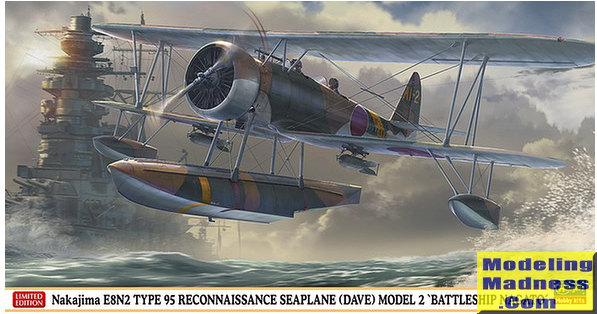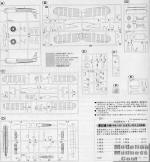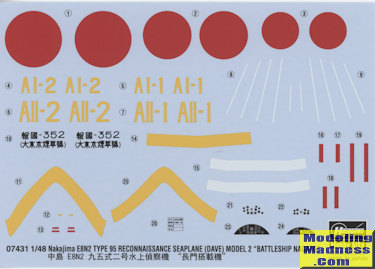Hasegawa 1/48 E8N2 Dave 'Battleship Nagato'
|
KIT #: |
07431 |
|
PRICE: |
3040 yen (around $29) from
www.hlj.com |
|
DECALS: |
Four options |
|
REVIEWER: |
Scott Van Aken |
|
NOTES: |
2016 Limited Edition |

The E8N was ordered into production, designated
Navy Type 95 Reconnaissance
Seaplane Model 1 in October 1935. A
total of 755 E8Ns were built by Nakajima and Kawanishi, production continuing
until 1940. It was subsequently shipped aboard most capital ships then in
service, 16 cruisers and five seaplane tenders.
It was used successfully in the Second Sino-Japanese
War not only for reconnaissance, but also for dive-bombing and artillery
spotting.
One E8N was purchased in early 1941 by the
German Naval Attache to Japan, Vice-Admiral Wenneker, and dispatched on board KM
MUNSTERLAND to rendezvous with the German auxiliary cruiser
Orion
at Maug Island in the Marianas. The meeting occurred on 1 FEB 1941, and
Orion
thus became the only German naval vessel of the Second World War to employ a
Japanese float plane.
Some aircraft remained in service with the fleet at
the outbreak of the Pacific War but they were soon replaced by more modern
aircraft such as the Aichi E13A and the Mitsubishi F1M, being reassigned to
second-line duties.
 Hasegawa
releases very few new kits each year and even fewer 1/48 WWII subjects.
Generally, for Hasegawa to produce a kit requires that it be able to be
boxed in a number of limited editions. Look at what they've done in the past and
you can see that to be true. It is also nice if the kit can be done in several
variants. In the case of the E8N, there were only E8N1 and E8N2 versions and
those differed only by the engine.
Hasegawa
releases very few new kits each year and even fewer 1/48 WWII subjects.
Generally, for Hasegawa to produce a kit requires that it be able to be
boxed in a number of limited editions. Look at what they've done in the past and
you can see that to be true. It is also nice if the kit can be done in several
variants. In the case of the E8N, there were only E8N1 and E8N2 versions and
those differed only by the engine.
While not exactly a household name in other parts of the world, this is
a Japanese plane and so it will sell very well in the home market, which is
really where Hasegawa tends to focus its products. If it sells elsewhere, so
much the better.
This kit is like every other new Hasegawa kit in the last dozen or more years in
that all the sprues are in one bag with a separate bag for the clear bits and
the polycaps. Molding is excellent and while some may think that the fabric
surfaces are a bit too exaggerated, most will not mind. The kit comes with a
pilot and gunner figure so you won't find any belt detail molded into the seats.
There is a lot of nice sidewall detail molded in place, but I'm sure the
resin folks will be offering upgrades soon for those who want it. The two
instrument panels have a choice of just instrument decals to be placed on a
black painted panel or a decal with the black background. A control stick and
rudder pedals are provided for the pilot. The gunner faces forward rather than
to the rear, which would have been nice.
Wings are split on the bottom with upper and lower halves for each side while
the upper wing halves are full span. Single piece tailplanes are provided and
there is a separate rudder. Bomb racks are provided and one needs to open the
holes in the lower wings for these. A nicely done single row radial is provided
with well molded exhaust stacks. In the front is an engine cover so the detail
provided is sufficient. A polycap is provided so you can push the two blade prop
in place after painting. Cabane and wing struts are N shaped and there are
separate aileron push rods. Hasegawa does not provide a rigging diagram, but you
can get that from the box art. Those with additional funds can buy their
aftermarket P.E. set that includes some of the rigging.
This is a central float plane and here is were there are quite a few struts. The
two piece float is held to the bottom of the fuselage by four single struts.
Wing tip floats are in two halves with one half having the vertical struts
molded in place. Add to it the angled inner struts and you are done. As with
 just about all float planes, you have a beaching dolly provided as well
as a rear float brace. Interestingly, only one of the main options has a rudder.
just about all float planes, you have a beaching dolly provided as well
as a rear float brace. Interestingly, only one of the main options has a rudder.
Instructions are well done with Gunze references. Two markings options are
shown, both in brown/green over grey-green. You are to mix the brown but there
are paints that offer this shade pre-mixed. One option is the box art plane from
the battleship Nagato in 1941. The other is from the battleship Mutsu, also in
1941. Note that you get two different tail codes for each ship. The decals are
nicely done and while the reds look rather bright, I'm told that is the proper
shade. The sheet image has been darkened to make the white easier to see.
To my knowledge, this is the first mainstream injected kit of this aircraft.
It was carried aboard every aircraft-capable ship in the Japanese Navy prior
to Pearl Harbor so it isn't like it was built in small numbers. Those who
like biplanes or float planes will be very pleased to have it. Though it
will take a bit of rigging work, and that may well cause some to shy away,
the end result will be a very nice model of an equally neat two seat
floatplane.
https://en.wikipedia.org/wiki/Nakajima_E8N
July 2016
Copyright ModelingMadness.com
Thanks to www.hlj.com for the preview
kit. You can get yours from this
link.
If you would like your product reviewed fairly and fairly quickly, please
contact
the editor
or see other details in the
Note to
Contributors.
Back to the Main Page
Back to the Previews Index Page


 Hasegawa
releases very few new kits each year and even fewer 1/48 WWII subjects.
Generally, for Hasegawa to produce a kit requires that it be able to be
boxed in a number of limited editions. Look at what they've done in the past and
you can see that to be true. It is also nice if the kit can be done in several
variants. In the case of the E8N, there were only E8N1 and E8N2 versions and
those differed only by the engine.
Hasegawa
releases very few new kits each year and even fewer 1/48 WWII subjects.
Generally, for Hasegawa to produce a kit requires that it be able to be
boxed in a number of limited editions. Look at what they've done in the past and
you can see that to be true. It is also nice if the kit can be done in several
variants. In the case of the E8N, there were only E8N1 and E8N2 versions and
those differed only by the engine.  just about all float planes, you have a beaching dolly provided as well
as a rear float brace. Interestingly, only one of the main options has a rudder.
just about all float planes, you have a beaching dolly provided as well
as a rear float brace. Interestingly, only one of the main options has a rudder.